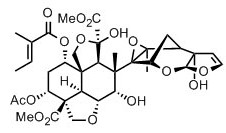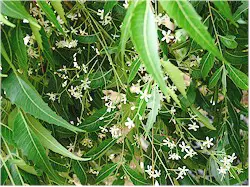Azadirachtin is a natural active ingredient of plant origin used in veterinary medicine mainly in dogs and cats against some external parasites (lice, fleas, flies, etc). It is also used against agricultural and household pests.
Common name: AZADIRACHTIN
Other names: Pyrethrum
Type: DETERRENT, INSECT GROWTH REGULATOR, INSECT OVIPOSITION INHIBITOR, REPELLENT
Some plants where it is found
- Azadirachta indica: neem, Indian lilac
- Melia azedarach: chinaberry tree, bead-tree, Cape lilac, syringa berrytree
- etc.
CHEMICAL STRUCTURE

EFFICACY AGAINST PARASITES
Type of action: Broad-spectrum insecticide, acaricide, tickicide, louisicide, larvicide
Main veterinary parasites controlled: flies, ticks, mites, lice, fleas, mosquitoes, roundworms, etc., mostly only in experimental studies
Mechanism of action: The molecular mechanism of action of azadirachtin is not yet completely understood and it may not be the same in different species. In some insects it seems to interfere with hormonal functions (mainly of ecdysone), and it also affects protein metabolism of immature stages. It also acts upon some chemoreceptors, which may explain its deterrent effect. Due to this mode of action azadirachtin does not quickly kill most adult parasites, but it disrupts their life cycle, which ultimately results in a population decline. Several subsequent treatments may be required to achieve it.
However, a "crushing" efficacy should not be expected from natural products, comparable to that of modern synthetic insecticides, which are more potent and persistent than any natural compound. Simplifying, it can be said that natural active ingredients can be useful in places or seasons with low parasite challenge, but may be insufficient for controlling well established parasite populations (fleas, ticks, mites, etc.) in pets, let alone in livestock.
Efficacy against a specific parasite depends on the delivery form and on the dose administered. Check the labels of the products available in your country.
Click here for general information on features and characteristics of PARASITICIDES.
SAFETY
Oral LD50, rat, acute*: >3540 mg/kg
Dermal LD50, rat, acute*: >2000 mg/kg
* These values refer to the active ingredient. Toxicity has to be determined for each formulation as well. Formulations are usually significantly less toxic than the active ingredients.
Azadirachtin can be moderately irritant for the eyes. Otherwise it is considered quite safe for humans and domestic animals.
It must be remembered that the natural origin does not guarantee that such compounds are less toxic than the synthetic parasiticides. They are as "chemical" as the synthetic ones. Toxicity is a matter of dose!
General information on the safety of veterinary antiparasitics is available in specific articles in this site (click to visit):
- General safety of antiparasitics for domestic animals
- General safety of antiparasitics for humans
- General safety of antiparasitics for the environment
MARKETING & USAGE
Azadirachtin is hardly used in veterinary medicine, excepting a few products based on neem extracts or on neem essential oils, which contain azadirachtin as well as many other natural components of neem.
Azadirachtin is manufactured mainly through industrial extraction of harvested plant material, but a lot of research is being done to develop industrial fermentation processes to improve productivity and reduce the production costs. Chemical synthesis in the laboratory was achieved only in 2007, but for the time being industrial synthesis would be too expensive due to the complicated molecular structure of azadirachtin.
Interest in azadirachtin is enormous in agriculture. Not so in veterinary medicine because efficacy of azadirachtin is still quite modest when compared with modern synthetic antiparasitic active ingredients. There have been some promising results of neem extracts against cattle ticks (Rhipicephalus microplus) but nobody knows when a commercial product may become available, if at all.
Use in LIVESTOCK: Yes, very scarce, a few repellents
Use in HORSES: Yes, very scarce, a few repellents
Use in DOGS & CATS: Yes, very scarce, a few repellents
Main delivery forms:
Use in human medicine: Yes, e.g. neem oil in traditional Indian medicine
Use in public/domestic hygiene: Yes
Use in agriculture: Yes
PARASITE RESISTANCE
Reported in livestock & horses: NO
Reported in pets: NO
Reported in other uses: YES, in a few agricultural pests
Learn more about parasite resistance and how it develops.
ADDITIONAL INFORMATION

Azadirachtin (a triterpenoid) is the main and most investigated insecticidal component of neem extracts. It is particularly abundant in seed extracts, but also in leaves and bark, together with other components with more or less strong insecticidal effect.
It is used moderately in agriculture, but mainly in the form of neem extracts, which contain between 300 and 2500 ppm (mg/L) azadirachtin. The differences are due to the natural variability of the plant material and to differences in the industrial production methods (pressing, extraction with solvents, etc.) used by manufacturers.
Neem oil is also used in traditional ayurvedic medicine, e.g. against skin disorders, inflammation, fever and rheumatism.
Azadirachtin shows two features common to many other natural insecticides: it is rather volatile and is unstable when exposed to sunlight. Consequently its effect in animals exposed to sunlight is very short: a few days or even only a few hours. This means that protection of the treated animals against re-infestations (residual effect) is virtually inexistent. This is particularly unfavorable for livestock that would need to be treated very frequently. However, for the same reason they do not leave chemical residues in food commodities (meat, milk, eggs, etc.), which is a benefit sought by organic producers.
Another disadvantage of many "natural products" extracted from plants is that quality (and thus efficacy) may vary, even if used following the label instructions, because producing extracts from heterogeneous plant materials is often less reliable than chemical synthesis.
Finally it must be said that in many countries registration of so-called "natural products" does not need a (serious) proof of efficacy, quality and safety as pesticides or veterinary medicines. This means that many such products have not been seriously tested in clinical trials in the field and consequently their efficacy and/or safety may not be granted. For such products, getting a market authorization does not need a substantial investment, which explains why there are so many brands in most countries.
- Click here to view the list of all technical summaries of natural antiparasitic active ingredients in this site.
- Click here to view the list of all technical summaries of antiparasitic active ingredients in this site.
- Click here to visit the article on medicinal plants with antiparasitic properties in this site.